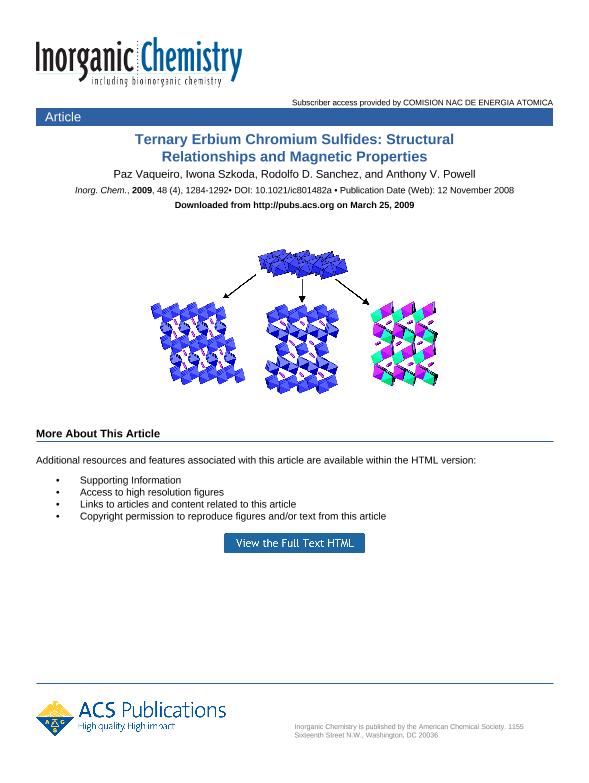Mostrar el registro sencillo del ítem
dc.contributor.author
Vaqueiro, Paz
dc.contributor.author
Szkoda, Iwona
dc.contributor.author
Sanchez, Rodolfo Daniel

dc.contributor.author
Powell, Anthony V.
dc.date.available
2019-01-24T20:50:20Z
dc.date.issued
2009-02
dc.identifier.citation
Vaqueiro, Paz; Szkoda, Iwona; Sanchez, Rodolfo Daniel; Powell, Anthony V.; Ternary erbium chromium sulfides: Structural relationships and magnetic properties; American Chemical Society; Inorganic Chemistry; 48; 4; 2-2009; 1284-1292
dc.identifier.issn
0020-1669
dc.identifier.uri
http://hdl.handle.net/11336/68574
dc.description.abstract
Single crystals of four erbium - chromium sulfides have been grown by chemical vapor transport using iodine as the transporting agent. Single-crystal X-ray diffraction reveals that in Er3CrS6 octahedral sites are occupied exclusively by Cr3+ cations, leading to one-dimensional CrS4 5- chains of edge-sharing octahedra, while in Er 2CrS4, Er3+, and Cr2+ cations occupy the available octahedral sites in an ordered manner. By contrast, in Er 6Cr2S11 and Er4CrS7, Er3+ and Cr2+ ions are disordered over the octahedral sites. In Er2CrS4, Er6Cr2S 11, and Er4CrS7, the network of octahedra generates an anionic framework constructed from M2S5 slabs of varying thickness, linked by one-dimensional octahedral chains. This suggests that these three phases belong to a series in which the anionic framework may be described by the general formula [M2n+1S 4n+3]x-, with charge balancing provided by Er3+ cations located in sites of high-coordination number within one-dimensional channels defined by the framework. Er4CrS7, Er 6Cr2S11, and Er2CrS4 may thus be considered as the n = 1, 2, and ∞ members of this series. While Er4CrS7 is paramagnetic, successive magnetic transitions associated with ordering of the chromium and erbium sub-lattices are observed on cooling Er3CrS6 (Tc(Cr) = 30 K; T c(Er) = 11 K) and Er2CrS4 (TN(Cr) = 42 K, TN(Er) = 10 K) whereas Er6Cr2S 11 exhibits ordering of the chromium sub-lattice only (TN = 11.4 K).
dc.format
application/pdf
dc.language.iso
eng
dc.publisher
American Chemical Society

dc.rights
info:eu-repo/semantics/openAccess
dc.rights.uri
https://creativecommons.org/licenses/by-nc-sa/2.5/ar/
dc.subject
Erbium-Chromium Sulfides
dc.subject
Single Crystals X-Ray Diffraction
dc.subject
Magnetic Properties
dc.subject.classification
Astronomía

dc.subject.classification
Ciencias Físicas

dc.subject.classification
CIENCIAS NATURALES Y EXACTAS

dc.title
Ternary erbium chromium sulfides: Structural relationships and magnetic properties
dc.type
info:eu-repo/semantics/article
dc.type
info:ar-repo/semantics/artículo
dc.type
info:eu-repo/semantics/publishedVersion
dc.date.updated
2019-01-22T15:11:30Z
dc.journal.volume
48
dc.journal.number
4
dc.journal.pagination
1284-1292
dc.journal.pais
Estados Unidos

dc.journal.ciudad
Washington
dc.description.fil
Fil: Vaqueiro, Paz. Heriot-watt University; Reino Unido
dc.description.fil
Fil: Szkoda, Iwona. Heriot-watt University; Reino Unido
dc.description.fil
Fil: Sanchez, Rodolfo Daniel. Comisión Nacional de Energía Atómica. Centro Atómico Bariloche; Argentina. Consejo Nacional de Investigaciones Científicas y Técnicas; Argentina
dc.description.fil
Fil: Powell, Anthony V.. Heriot-watt University; Reino Unido
dc.journal.title
Inorganic Chemistry

dc.relation.alternativeid
info:eu-repo/semantics/altIdentifier/url/https://pubs.acs.org/doi/abs/10.1021/ic801482a
dc.relation.alternativeid
info:eu-repo/semantics/altIdentifier/doi/http://dx.doi.org/10.1021/ic801482a
Archivos asociados
